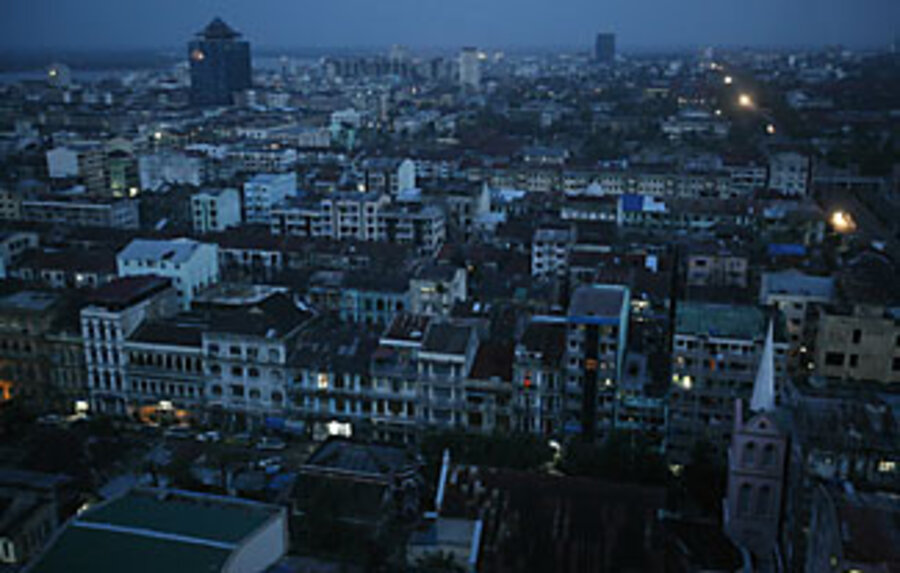In darkened Rangoon, Burmese get resourceful
Loading...
| Rangoon, Burma
Unable to read street signs at 8 p.m., a Burmese driver was lost in the darkness somewhere in a western township of his native Rangoon (Yangon). Ghostly figures of people emerged in the headlights, like deer on a mountain road. In the flickering light of passing cars, shoppers milled around a bustling food market, fumbling for money and buying fruit and vegetables sight unseen.
Four weeks after cyclone Nargis, electricity has not been fully restored to large areas of the largest city in Burma (Myanmar). "It hasn't been fixed, and it might not ever be fixed," says a student, reflecting an often-heard sentiment.
Power went out everywhere for three days after Nargis hit May 2 and May 3, knocking out communications across the south. Since then, government workers have gone door to door in Rangoon, demanding 50,000 kyat (about $50) to turn the lights back on in a home or office, locals say. Many families can't afford to pay that, a sum that is more than their monthly income.
For 10 days after the cyclone, one well-connected family tried to stand down what they jokingly call "the prince of darkness." They implored him to serve his country, not himself, during a time of national mourning. The official said he had no choice, given the scarcity of resources. Low on candles and flashlight batteries, the family gave in, and got enough light to remove mangled trees and repair a roof.
Overwhelmed by a disaster that would challenge authorities in any country, the state appears to lack the resources to restore full power, which has always been on-again, off-again in Rangoon. Local reports say the storm knocked out more than 70 percent of Rangoon's 2,500 factories, including many power stations. The city consumes about half the country's electricity, especially at 500 factories in the Hlaing Tharyar Industrial Zone, which employ an estimated 120,000 workers. In another zone, one company, MGS Beverages, has been running on costly generators to produce vital drinking water.
Lights equal power
The ability to light up the night shows who has power and money in Rangoon. Near the Rangoon River port, the triple-diamond logo of Mitsubishi oozes red into a working-class neighborhood, where mongrels stalk people in the dark and snap at their heels. In the city center, strings of festive lights emanate from upscale restaurants and hotels, serving a new influx of aid workers.
Above all else, Shwedagon Pagoda, perhaps the most magnificent site in southeast Asia, shines gold upon the blackened city below.
Undaunted, Rangoon residents have invented ways to overcome their powerlessness. Lacking working elevators, residents on upper floors of apartment blocks use ropes to drop down money to street vendors and pull up newspapers and water bottles.
Outside a pagoda, a street vendor uses a jury-rigged car battery to illuminate a tray of peanuts for sale from his bicycle cart. Car batteries are everywhere, lighting up tea stalls and snack joints. Streets are dotted with red boxes, in some cases containing auto engines converted into local power generators.
Since Burma doesn't produce generators, consumers have to pay around $100 for Chinese models, says the manager of an electronics store. But since diesel prices have doubled or tripled in the past month, others are waiting in the dark, hoping prices will come down.
Searching for TV signals
Those who have power are desperate for TV. The store manager says satellite dishes are a popular item. Technicians can be seen throughout the downtown core, carrying black panels on their backs or installing them on rooftops. Watching television, from home or abroad, at least offers respite from a month of national anguish.
In areas with electricity, locals are flocking to Internet cafes tucked away in the side-streets of bustling residential areas. Often run by long-haired rockers or young cyber-punks in longyis (sarongs), they're doing a good business, charging 500 kyat (about 50 cents) or more for an hour of surfing, accompanied by rock, rap, or religious music. But the surfing is often slow, and access comes in waves that crash throughout the day.
Some locals say they look to the Internet to fill the void of Western-style news in the local TV, radio, and print media. Most Burmese Web-surfers in the public Internet cafes, however, seem more interested in uploading family photos or chatting with friends than reading news sites, such as Google or Yahoo, that are sometimes blocked. Communicating by Internet is often cheaper and safer than paying 50 to 100 kyat per minute for local calls on patchy phone lines.
Many people doubt that authorities, who control the country's only server, have the time or energy to read through every individual e-mail. Already overloaded, the narrow Internet highway has been further jammed by the arrival of foreign aid workers, who are forced to rely on Internet communications because satellite phones are banned and cellphone SIM cards cost a whopping $2,000.
After the cafes close around 9 p.m., surfers wander home in the dark, avoiding potholes and stepping around puddles and prowling dogs.
"We can survive anything because we have to," says a Burmese netizen. "We are the toughest people in the world. When the apocalypse comes, we will be the last people to survive, because we are already near it."





